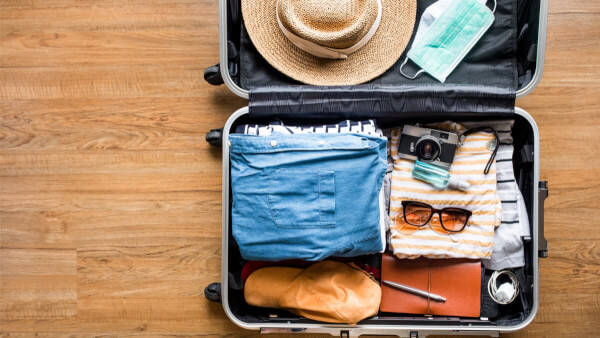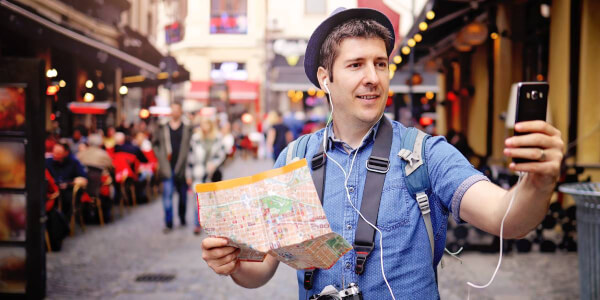UBank vs Wise card - Which is the better travel card to use overseas in Australia?
Looking for a travel card to use overseas? We compared the fees, features, and benefits of two top travel cards: Ubank vs Wise, for Australian travellers.

When it comes to vacations, we all want to get the best value for money on our trip. One potential pitfall, when it comes to planning your spending while you’re away, is unexpected bank fees and charges. To avoid these, you’ll need to decide in advance how best to pay your way while you’re travelling.
Using a card is often a good choice. It’s safer than carrying lots of cash, and your transactions are recorded and monitored, so you have some protection against fraud. However, if you’re considering relying on your Mastercard, there are fees and charges you need to know about before you go. Invest the time to understand and avoid some of the common problems travelers experience, and you can make sure your money goes further.
Read this guide to find out:
🌏 Heading abroad? Compare the best travel cards in our guide for the smartest way to spend overseas.
Mastercard is fairly widely accepted around the world, so you should be able to use your U.S. issued Mastercard wherever you are, to make purchases or withdraw cash. Don’t forget though, most credit and debit cards used in Europe, Canada and Australia will have ‘chip and PIN’ technology. To withdraw cash from an ATM, or use any sort of unmanned payment system - in a gas station or vending machine for example - you’ll need to know your four digit PIN number.
You can still use your magnetic stripe card outside of the U.S. - retailers and restaurants just process a transaction by swiping the strip and taking your signature instead of a PIN. However, this process is seldom used, so staff might not be familiar with what to do. In most cases, however, the payment terminal will guide the staff member through the steps needed to take payment using the magnetic stripe.
In most restaurants and cafes in Europe, waiting staff will bring a card terminal directly to you and charge the entire transaction in your presence. It’s very unusual for you to have to let your card out of your sight. By taking payment right in front of you, you can be sure the transaction has been completed properly.
When you’re travelling, you’ll also find that contactless payment technology - which allows you to simply ‘tap and go’ - is very popular in Europe, Canada and Australia. Because of its convenience, this system is becoming more popular in parts of the U.S. as well. If you have a contactless card already, then you can use it wherever you see the contactless symbol displayed, just like at home. Contactless technology hasn’t caught on everywhere yet, though, so you may be out of luck.
Overall, you should have no problem paying with your Mastercard abroad. It’s likely, however, that there will be additional fees to pay when you use your card overseas. Wherever you go, you’ll come across places that don’t accept cards in any form, such as small local stores or some taxis. In most cases, taking some local cash with you is a sensible idea, too.
Whether you choose to spend abroad using your debit or credit card, you’re going to incur some fees.
To figure out what spending on your Mastercard overseas is going to cost you, you have to know the system. Firstly, the bank will use the daily exchange rate set by Mastercard, to change the cost of your purchase into U.S. Dollars (USD). In most cases, you’ll find that this is slightly less favourable than the real exchange rate you find on Google. But Mastercard wants to keep their customers as happy as possible, so these rates are pretty fair as long you’re being charged in the country’s local currency. You might run into problems though, if you’re charged in USD through a system called Dynamic Currency Conversion (DCC). If this happens you can be hit by exorbitant mark-ups in the exchange rate used. But we’ll come to that later.
After adding any exchange rate mark-ups, card providers will then usually take their profit from the transaction. This is usually done via a charge known as a foreign transaction fee, and calculated as a percentage of the amount you spent.
If you’re taking cash out of an ATM, there may also be further charges to pay. This could be a further percentage added onto the fees you’ve already paid, or a fixed dollar amount per withdrawal. Each card issuer has a different approach, but it’s important to understand what the rules are for your Mastercard. That’s because taking out larger chunks of cash might be better if you have a fixed fee per withdrawal.
It’s also worth understanding the small print because some cards include fees for other ATM services, such as checking your balance. Some Wells Fargo cards for example come with a cost of $2, simply for getting your bank balance from an international ATM outside of their network.
Aside from whatever charges your home bank adds, some individual banks or ATM providers might levy their own fees on top of your bank charges. Often this can be avoided by choosing the right ATM. By using an ATM from a partner bank, which has an agreement with your home bank, you might avoid cash fees altogether.
When you’re making a purchase, you might also be asked if you want it to be processed in USD instead of the local currency. This is known as Dynamic Currency Conversion (DCC). It sounds super convenient, but actually it’s a common problem for travellers, and should most definitely be avoided.
That’s because the currency exchange rates applied when using DCC are never as good as those your card provider gives. They’re set by the local company or ATM machine and although your home bank wants to make sure you’re happy with their services, a foreign provider has no such obligation. They’ll mark up the exchange rate and pocket the difference. If possible, choose to pay in the local currency, and you avoid this issue entirely.
If you’re using a credit card abroad, the process to work out the fees and charges will be similar. But you also need to take into account any interest charges you’ll incur if you don’t pay your bill at the end of the month. Check out the details of your specific card, though, because some credit cards do come with promotional offers. If they mean that you’ll have a grace period during which your purchases are interest-free, you might pay less overall by using your credit card.
To get the exact details about what fees you’ll be charged, you need to check online or on the back of your card statements. The fees below are a guide, but different card types have some variances, including promotions and opening offers.
Here are the fees you’ll be charged to use your U.S. Mastercard while you’re away, from some of the popular card-issuing banks:
| Bank of America | Citi | Capital One | Wells Fargo | |
|---|---|---|---|---|
| Standard foreign transaction fee | 3% | 3% | 0% | 3% |
| ATM Usage Foreign Cash Fee/ Cash Fee | No extra fee if using an ATM with an international partner bank. Outside this network, the ATM administrator decides the fee. | Depends on the card chosen. Some cards will be fee-free in the Citi ATM network. | Depends on the card chosen. | $2.50 - $5 Depends on the ATM used, may be fee free within the Wells Fargo network. |
Mastercard has a handy online tool to help you work out what you’ll actually be charged if you make purchases abroad. For example, if you spend €100 on a romantic night out in Paris, and use your U.S. Mastercard, the exchange rate taking into account the foreign transaction fee charged by your card provider, in this case 3%, could have looked like this:
Using this rate, the final bill totalled $118.30. The exchange rate used will move with the market, of course, so it’s worth checking the online tools regularly.
Before you take off on your trip, you should make sure you know how you’ll cope if your card is lost or stolen when you’re on your vacation.
If something happens and your card is missing, you’ll have to contact your card issuer to report the loss. They’ll cancel the card so your money is safe. Depending on their policy, and the card type you hold, the bank may issue you a temporary card or some emergency funds to tide you over while you’re away.
You’ll find the number for reporting a lost card on your statement, online or on the back of your card. Make a note of it, and keep it separate to your card during your travels. Keeping a list of important numbers with your passport is a good idea, so you know where to look if you hit problems. You can find contact numbers and forms for some of the main Mastercard issuers here:
Another option is to get card protection insurance. This will make sure you get additional help if your card is lost or stolen while you’re abroad, but comes at a fee. Card protection can be set up via your bank or an insurance company. Of course, if you do take this additional protection, make sure you have all your policy details with you when you travel.
The deals available on credit and debit cards vary wildly depending on which bank or card issuer you use. Therefore whether it’s better to use one card type or another will depend in part on the deal you’ve got on your preferred card. There are pros and cons to both credit and debit cards, so your personal preferences and spending habits will help you figure out which suits you best.
For example, a debit card is often better if you want to take cash from ATMs in your card’s network. Banks and bigger card issuers are usually part of ATM networks, which means that they work with partner banks in different countries. This means that if you use specific ATMs you can benefit from reduced fees, or even pay no fees at all. Check out which ATMs are free to use overseas before you travel - otherwise you’ll be hit by hefty costs.
On the other hand, if you need to spread the cost of your vacation over time, a credit card might work better for you. Some cards also offer cash-back or rewards so you can travel more in future. Make sure you weigh up the potential benefits against the additional interest costs incurred if you don’t pay your bills immediately, though.
Taking cash withdrawals on a credit card is usually not a good idea. Charges are high and frequently uncapped, and many banks start to charge interest straight away for cash advances, rather than offering any grace period. However, spending on a credit card can certainly provide greater security than using cash. The bank will monitor your purchases and help if you’re the victim of fraud. To benefit, you should keep all your receipts and check your card statements thoroughly.
Banks tend to be quick to block cards, to avoid the losses and hassle incurred by fraudulent activity. Therefore, Mastercard advises that you tell your bank if you’re travelling abroad. However, not all banks insist on this step, so you should check with your local branch or online. Either way, if you plan to be away for a large chunk of time it’s probably worth letting your card issuer know.
Even if your bank doesn’t need you to tell them your vacation plans, you must make sure they have your correct contact details. That’s because, if the bank systems suspect fraudulent activity on your account, they’ll call you. If the number they hold is wrong or you’ve turned your phone off while you’re travelling, the bank might block or limit your account while they make further checks and try to get hold of you. This is especially likely if you’re travelling to someplace unusual. If your destination is a hotspot for fraud, then it’s in your interest to make sure your details are all up to date.
You don’t want to be stuck without any means of payment, so it’s well worth having a secondary bank card just in case there’s a problem with your usual card. Keeping a small amount of local currency is also smart, in case you find your card isn’t accepted.
It’s very easy to overspend when you’re on vacation. Not only are you too busy having fun to do the sums, the currency conversion makes life complicated, too. To avoid any nasty surprises, you might want to try an app to monitor and manage your cash flow while you’re away. Setting a daily spending limit is another way to help make sure you don’t accidentally spend way more than you intended.
Nobody wants to worry about money on vacation. Use these tips to stay safe while you spend abroad, and understand in advance, the fees and charges you need to plan for. Then all you have to do is relax and enjoy!
*Please see terms of use and product availability for your region or visit Wise fees and pricing for the most up to date pricing and fee information.
This publication is provided for general information purposes and does not constitute legal, tax or other professional advice from Wise Payments Limited or its subsidiaries and its affiliates, and it is not intended as a substitute for obtaining advice from a financial advisor or any other professional.
We make no representations, warranties or guarantees, whether expressed or implied, that the content in the publication is accurate, complete or up to date.

Looking for a travel card to use overseas? We compared the fees, features, and benefits of two top travel cards: Ubank vs Wise, for Australian travellers.

The most cost-effective ways to get foreign currency. Compare banks, exchange services, and ATMs with tips to avoid hidden fees and get the best exchange rates.

Planning to use your UBank card to make ATM withdrawals internationally? Read on to understand the true cost of overseas transactions with UBank.

Wondering if Travel Money Oz is the right solution for you? Our guide outlines everything you need to know about their currency exchange and travel money cards.

If you're trying to decide between Travelex and Travel Money Oz for your international money needs, read on for our side-by-side comparison of the features.

Side-by-side Comparison of Westpac Travel Card vs Wise Travel to help Australian users decided which is a better travel card for spending abroad.